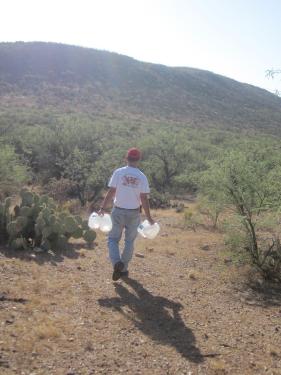Cool clear water…
We meet in the early morning hours when the temperatures are cool and take off in “the Beast”, an old Ford Explorer that has seen a lot of dust and miles. The back of the Samaritan van is loaded to the ceiling with crates of water jugs. I am going on a “water drop” with 2 veterans of the back country. We will carry jugs of water to 6 water stations in Southern Arizona where migrants have been known to stop. The desert is criss-crossed with trails and paths—and there are tracks everywhere. Some are cows, some are coyotes (4-legged), and some are the soles of well-worn shoes.
The road is a teeth-rattling washboard gravel road. We see a few RV’s and campers parked miles into the vastness of the Sonoran desert. It is deer hunting season, and I am glad I have on a bright red t-shirt. My Samaritan friends have been on this route many times, and I must say, zig-zagging around on these roads soon has me totally disoriented. Dirt roads curve off in all directions.
We stop at a water station that is about 200 yards off the road. How these 2 guys know where to go is impressive. The crates hold six gallons each (about 48+ pounds), and so I carry one end of a crate while my friend carries the other. We stumble along a path teetering with our load, but make it to the first water station. There are 8 gallon jugs scattered about under a mesquite tree. A couple of jugs have been chewed up—probably coyotes, my friends tell me. The other jugs are empty, and they are reasonably sure that migrants have been through this section. We exchange the empty jugs for our full ones. This time we leave the jugs in a crate so the coyotes can’t chew up the plastic and empty the water.
Our next stop is discouraging. All of the water jugs have been emptied, but probably not by migrants. My friends surmise that the jugs have been emptied by people “not supportive of migrants.” Vigilantes? Irate ranchers? Border Patrol? Who knows…. We have a quick discussion about what to do and decide to leave another dozen or so water jugs. Better to have this life-saving nectar in the desert for someone who is in desperate straits than to leave no water at all.
Finally we reach the “bicycle stop”, a water station with an ancient bike leaning beside an old mesquite tree. It has been there for many years, and no one knows the story behind the bike, but it is a well-traveled trail for migration. I get the feeling that we are being watched somewhere up that canyon, or down that arroyo. We are not alone. I do not feel afraid out here. In fact, I wish we could just hang out for awhile in the shade of these trees and watch the hawks. Baboquivari looms up in the distance—the sacred mountain of the Pima and Tohono-O’odham Indian tribes.
My Samaritan friends have many stories to tell of ranchers who are supportive and compassionate about migrant travelers on these trails, and ranchers who are angry about the whole immigration issue. They tell me of water bottles that have been slashed, and their theories about who is slashing them. Feelings run high in Arizona when it comes to the issue of immigration.
I hear a lot of vitriol and anger toward Mexicans and Latinos from Central America. The anger is focused—arrest them, they are breaking the law, send them back where they came from! The Latinos feel it—it is palpable and present every day in towns and cities.
And yet—this is what astounds me. When I talk with migrants at the comedor in Nogales, Sonora, they are open, wanting to share their story on a very intimate and emotionally vulnerable level. In spite of the unspeakable experiences they have had in the desert, in detention centers, and with sadistic guides and insensitive US Federal agents, they do not hate us. I find this astounding. It is a lesson that never ceases to amaze me.
These are good people. And this water we leave in the desert is holy water.






Believe me, Peg, I’ve had my “issues” with “Federal agents” after I emigrated to Southern Arizona from Connecticut 14 years ago.
But I’m a bit bothered by this phrase you composed – “sadistic guides and insensitive Federal agents.”
Which seems to me to be an unfortunate coupling, because from my personal experiences, this phrase seems unfair to both the “guides” and “Federal agents.”
That’s because, during my hikes down in the Santa Cruz River Valley below my home, I’ve met “guides” (AKA “coyotes”) who genuinely seemed to care about their “pollos” (AKA “Chickens”).
I have also met many Federal agents during my hikes in the valley.
But only a few of them were jerks, like the idiot who demanded to see my ID when he “caught” me hiking in the valley.
But the majority of those Federal officers are highly trained, professional police officers.
Quite a few of those, during conversations I had with them down in the valley, share the same compassion you and I so obviously feel for the majority of our “border trespassers.”
You are absolute right—not all “coyotes” and Federal agents are bad guys. But when I talk to a migrant that was abandoned by a coyote because he/she was not keeping up with the group, or another migrant that was “roughed up” while being shoved into a Border Patrol vehicle, I get angry. And I generalize. There are always gonna be some bad apples, as my Mama used to say. I just think that our country is better than this.
Thanks for your comment—it keeps me grounded. –Peg
What a delightful blog this is! Keep it up.